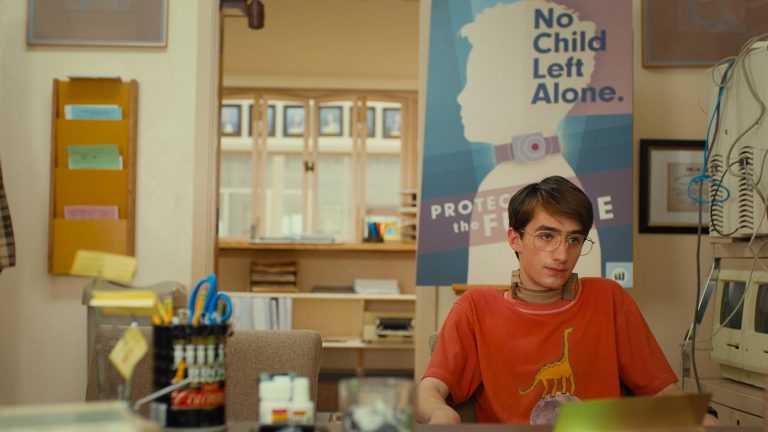Three Pines (Season 1), Episodes 1 & 2: For such a hit-or-a-miss genre, murder mystery shows its time-proof infallibility by retaining its indisputable intrigue every time a new one comes around. What’s inside is a whole other discussion, but it undoubtedly makes you take a look. With the first two episodes of the Amazon Originals’ new whodunnit Three Pines dropping, the genre has two of its most bewitching elements coming together to not just make you turn around and take a look but to make you hang around for more.
On the one hand, we have the instigations of two gripping crimes–one as vague and haunting as they come–and another baffling with its layered scrutiny. On the other hand, the show establishes a fascinating detective, likable enough with his adorable pep-talks and shockingly sharp with his impulses. While it’s too soon to effectively predict whether Three Pines will be able to keep up with the impressive standard, it has set with White Out Part 1 & 2, I would keep my hopes high for this one.
Only scratching the surface so far with the ever-disturbing struggles of the indigenous communities and the triggering neglect they face from law enforcement, the first two episodes establish the grittiness of the tension that is to surround the snow-clad terrains of Canada. A missing girl, howling protesters, a seemingly disconnected murder in the next-door town of Three Pines–and connecting it all is the celebrated detective Armand Gamache. The second Alfred Molina appears on screen, he wears the very existence of detective Gamache as a suit, and it is as though he has never been anyone else.
Three Pines (Season 1), Episodes 1 & 2 Recap
The show opens up with a raging protest of indigenous people growling against the indifference of the police when it comes to crimes against the people of their community. Leading the fast-escalating protest is Missy Two Rivers (Crystle Lightning), mother of Blue Two Rivers (Anna Lambe), an indigenous woman who has been missing for over 13 months. Fuming against the lack of effort by the police department, Missy gets shoved into the back of a car. Rescuing her comes to the one man who seems to have some compassion; detective Armand Gamache (Alfred Molina). Gamache drives Blue’s family home, and going against his own better judgment inadvertently gives them hope that he will find her.
Back at home, while his family and friends drown in the joy of Christmas, Armand asks for Blue, and his colleague Pierre lets him in on the information that comforts and disheartens him. Blue was apparently seen leaving with her partner Tommy in Kevin Kis’ truck. Gamache pleads with Pierre to run the plates and find out where the truck is now.
While Gamache’s Christmas is engulfed with his concerns for Blue Two Rivers, the snowy landscape of Three Pines echoes the emptiness Crie (Roberta Battaglia) feels when her mother CC (Simone-Elise Girard) chooses to fight with her father Richard (Robert Moloney) instead of hearing her sing. Her affair with photographer Saul Petrov (Iannicko N’Doua-Legare) is the reason why she was late in the first place. Crie’s lack of reaction to her mother’s violently abusive words proves that it isn’t anything new.
The next morning, Three Pines sees a freak death. CC de Poitiers gets electrocuted in a chair while the crowd of people is distracted by a curling match. The peculiar nature of the death brings about the involvement of Gamache and his subordinates, Jean-Guy and Isabelle Lacoste. To join them in the unwelcoming town that reeks of guilt and relief is local cop Nichol.
Gamache soon comes to realize that it isn’t just her immediate family that CC treated awfully. Nobody in the otherwise pleasant town particularly liked the celebrated writer of Be Calm. But did they hate her enough to kill her? It’s not just the furious fact that CC had made her home where once a racist school of abuse stood. She has also never treated a person in this town with a smidge of kindness. Gamache also learns that her husband is sort of an electric nerd, and even though he denies the knowledge of CC’s affair, he isn’t very convincing about it. At that point, the entire town, including Richard, falls on the suspect list.
While that investigation is ongoing, Gamache finds out that Blue Two Rivers was last seen in Brooklyn, and he finds a recent picture of her with Tommy and a whole group of people. Her family, however, isn’t accepting of the possibility that Blue has run away. Missy is inflexible in her argument that Blue would never leave her little daughter Pearl behind. The grieving mother believes Blue has passed and nobody is trying hard enough to find her.
A flashback lets us look into how CC murdered her abusive mother. Back in Three Pines, Gamache removes Saul from the suspect list. “He loves her too much.” And the circumstantial nature of Richard lets him off the hook. Figuring out the word puzzle of Be Calm, he pays Bea a visit at the local art studio that certainly was a misused inspiration that CC’s book was a gross derivative of. Meanwhile, Nichol throws another riddle at Gamache. CC had lied to everyone about her identity, and her real mother is Emilie (Jill Frappier).
Confronting Emilie about the same, Gamache finds most of the answers he has been looking for. Emilie clears up that she is not CC’s mother but her aunt. CC’s real mother had a mental break that made her destroy everything and attack her own daughter. When CC returned to town, Emilie hoped to be a part of her and Crie’s lives. But CC had other plans. She threatened Emilie that if she ever revealed their relationship to anyone, she would take Crie away. Of course, this revelation effectively makes Emilie the prime suspect, but Gamache decides to let her go for the moment.
Three Pines (Season 1), Episodes 1 & 2 Ending Explained
Who killed CC de Poitiers?
Finding out that Emilie is missing may not have been something Gamache didn’t expect, but the confession tape she has left behind comes as an absurd shock. Before leaving, Emilie had confessed to the murder of CC; lest it gets ignored, she had described the crime in exhaustive details that only the murderer would know. Knowing that Bea and Emilie are close, Bea is the first person Gamache visits to find out where she may have gone. Apprehensive at first to tattle on Emilie, Bea finally gives in to Gamache’s desperate queries because she truly believes that he means well. He learns from Bea that there’s only one place she’ll go–where her husband and her daughter lost their lives in a car accident.
Braving the snowstorm, Gamache drives to the place and spots Emilie almost buried in snow. With a promise of help, she comes back. He is sufficiently satisfied with Emilie’s confession because who else would know of the niacin that was put in CC’s coffee to get her to take off the gloves? In his impulsiveness and understandable distraction, Gamache forgets to check all the boxes before coming to the conclusion that it is, in fact, Emilie who had murdered her niece.
The realization hits just in time, perhaps too close, when Nichol lifts up CC’s boots, and Gamache notices that the metal spikes are placed at the bottom. Knowing that she’ll be wearing shoes with metal spikes is crucial to the murderer’s plan, and there’s no way Emilie could’ve known of that. It has to be someone who has been in much closer quarters with CC. And if it isn’t Saul or Richard, only one person left could harbor enough hatred to end her life.
Gamache had taken Crie’s silence when he first saw her as a sign of grief. In quietness and retrospect, something from Gamache’s own past clouds his consciousness and makes him find understanding through only relatability. Perhaps that is what made him think that Crie is depressed. But now, meeting her for the second time, he is certain that what he had mistaken as grief was a relief.
Sitting in the basement of what used to be a residential school, Crie doesn’t have to say a word for Gamache to connect the dots. Right beside is the old shackle chair that was once used to punish indigenous children. Gamache realizes that the abuse has surged too far for little Crie to take, and she decides that the only fitting punishment for her cruel mother is the capital one. While finding an understanding ear for the first time, Crie discloses that she had witnessed CC killing her mother. The cycle of abuse that Crie happened to be born into clearly took a scarring toll on her little mind and so much so that she took it upon herself to do the extreme and end it. Emilie only took the fall because she genuinely cares for Crie and believes that she doesn’t deserve to be punished for a crime that only brings on sighing relief for her family and the entire town.
Where did episode 2 leave us, and what do we expect next?
Police found out that drugs might have been involved in Blue’s disappearance, and it doesn’t comfort Missy. She’s constantly battling her gut feeling that her daughter is dead and the more seemingly realistic possibility that she might have just left her family behind. Getting out of his car back in his town, Gamache can’t possibly fathom what horror he’s about to witness. Missy has snuck into the roof of the department’s building, and before Gamache can reach her, she jumps to her death.
It is likely that what haunted her, as she had confided to Isabella, was her failure as a mother. Missy’s own mother had strived through endless struggles and still provided her with safety and love. Missy felt that Blue’s disappearance was her own failure to keep her daughter safe. It’s also possible that Missy wanted her death to be the wake-up call for the department to finally start putting some real effort into finding her daughter.
To think about the convenience of finding CC’s murderer in a strikingly short span of time and that too with a satisfying conclusion– it all just seems a bit too easy for the narrative. CC not only bought a house that used to be a place of racial horrors but also nearly plagiarised the name and the idea behind an art studio that deals with the issues of the indigenous community. It is entirely plausible that her wrongdoings weren’t limited to her offputting behavior. Just her coldness isn’t enough for an entire town to come together and rejoice as though their Frankensteinian monster is dead. Could there be more to the darkness of CC de Poitiers?







